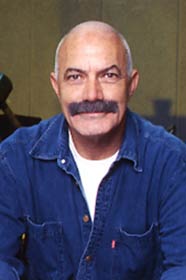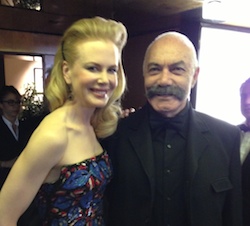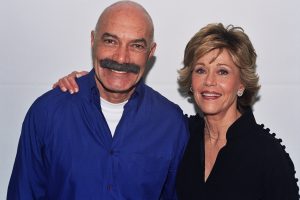Cate Blanchett and Todd Field Lift the Curtain on Their Oscar-Season Masterpiece
Blanchett has given one of the most rapturously reviewed performances of her career as Lydia Tár — troubled, lesbian, world-famous conductor of a major orchestra in Berlin.
Field got into a bad car accident trying to get the screenplay to Blanchett. Field hadn’t made a feature since 2006’s “Little Children” — and, unbeknownst to Blanchett, had written “Tár” only for her, during 12-week in the lockdown stage of early COVID.
In September 2020, Field was driving while on the phone with Blanchett’s agent, Hylda Queally, who’d just delivered the news that her client was booked for the next three years and wouldn’t be able to star in his movie. And then he crashed.
That “Tár” started with a car crash feels right. That rattling sound you hear in Lydia’s Porsche as she drives? It’s recorded from Field’s own car, never fixed properly after the accident. There are ghosts in “Tár,” which this ghost of Field’s real-life bad experience illuminates.
The movie is a fever dream — a layered piece of art that rewards repeat viewings. For the fans of “Tár,” it’s a puzzle, with clues so subtle you have to freeze the frame to catch them.
Lydia is being haunted, and that theme resonates with Blanchett: “I think ‘Tár’ speaks to a moment in a woman’s life when she is moving inexorably, as we all are, towards death, and we try to outrun that very thing — we try to outrun the unpalatable sides of ourselves. We try to hide.” Yet Lydia Tár has come to a point in her life where there is no hiding.
“Tár” is hyperspecific about Lydia’s world, down to its smallest details: Her book is being published by the Nan A. Talese imprint at Doubleday; her bespoke suits are tailored by Egon Brandstetter, playing himself; the person interviewing her at The New Yorker Festival is the writer Adam Gopnik; we hear her being interviewed by Alec Baldwin on his “Here’s the Thing” podcast. “Tár” feels so real that a significant number of people who’ve seen it leave the theater thinking it’s a biopic of a living conductor named Lydia Tár — and they google her, asking questions like “Where is Lydia Tár now?”
Blanchett and Field have a lot of affection for each other. At the photo shoot for this cover story, when photographer Alexi Lubomirski asks Blanchett to channel Lydia’s rage by throwing sheet music at the camera, she does a few takes. Then Field pipes up from the back of the room, telling Blanchett to toss the pages higher so they stay in the air longer. She follows his direction and there we go! That’s the shot we end up using.
They talk to each other, still eager to explore “Tár” and the conversations around it. Blanchett has just finished filming “The New Boy,” in which she plays a nun, and she has a bad cold. “I’m not making any sense! I can’t even remember what you asked me,” she says more than once, after having made perfect sense.

“Tár” is an art-house movie that actually punctured the zeitgeist. During Halloween, Lydia Tár costumes populated Instagram. “That was unexpected!” Blanchett says.
Yet “Tár” has also become emblematic of the difficult period during COVID for the movie business, and the continuing uncertainty around the financial viability of prestige films. A New York Times story from last month, headlined “Highbrow Films Aimed at Winning Oscars Are Losing Audiences,” used an image of Blanchett as Lydia, looking spooked.
Peter Kujawski — chair of Focus Features, the studio that made “Tár” — waves away those concerns: “That’s what a film like this has always looked like — a story told in months, rather than in days and weekends.”
After screening “Tár” for the first time, an initial cut that Kujawski says was “the movie — and as complete a thought as the movie you watch now,” Focus came up with a release plan. It would have a festival debut, then be released in theaters in the fall, premiere on premium VOD after that and come out internationally in 2023.
That “Tár” has grossed a mere $5 million in theaters as of this writing, and is a symbol of the box office crisis for Oscar-oriented movies, was decidedly not part of that plan. But regarding “Tár” and movies like it, Kujawski says, “We’re committed to this, and doing it not on some sort of foolish, idealistic quest, but because it’s working.”
Blanchett has won two Academy Awards and three BAFTAs, was the co-artistic director (with her husband, Andrew Upton) of the prestigious Sydney Theatre Company for five years and has starred in blockbusters such as Peter Jackson’s “Lord of the Rings” trilogy and “Thor: Ragnarok.” And still she was petrified at the start of production on “Tár.” Preparing for the role, she had largely created Lydia from the outside in: She’d learned to speak German and how to play piano; she’d studied the work of Mahler, since Lydia’s recording of his Fifth Symphony is to be her greatest achievement.
She’s played Americans many times before; both of her Academy Awards — for “Blue Jasmine” in 2014 and as Katharine Hepburn in “The Aviator” in 2005 — were roles in which Blanchett manifested aristocratic women with the voices to match. Blanchett’s own accent, she says, is always in flux, especially when she returns from the States. “When I go home and I see my family, I sound much more Australian,” she says. “It’s so embarrassing. My kids go, ‘Just stop it!’”
To bring Lydia’s cultured, counterfeit speaking voice into being, Blanchett listened to recordings of Susan Sontag — that famously highbrow, queer member of New York’s elite — whom she calls “a really razor-sharp, absolutely authentic public intellectual.”

Blanchett compares deciphering Lydia to playing Hedda Gabler, whom she calls “an intensely ambiguous character.” In 2004, having trouble with the iconic stage role, she asked her husband for his advice. “And he said, ‘Well, why don’t you just try doing one thing. And then, in the next instant, do an entirely equal and opposite thing — and then the audience will butt those two events together, and they create the character.”
Blanchett wanted to take tiny bites. With “Tár” beginning to shoot in Dresden on Sept. 18, 2021, she asked to start slowly: perhaps with some scenes without dialogue, she suggested to Field, or of Lydia crossing the street? What Field told her instead was they had to film all of Lydia’s conducting scenes with the Dresdner Philharmonie symphony orchestra — standing in for the fictional Berlin Philharmonic —at once.
“And I was like, ‘Stella!’” Blanchett bellows, affecting her best Brando as Stanley Kowalski in “A Streetcar Named Desire.” “I just thought, ‘You couldn’t have delivered a worse piece of news to me.’”
But, in fact, “it was a gift. Because I started with what she loved,” Blanchett says. “And I realized the stakes. Because when we lose what we love, when we lose our identity … Without the music, who is she?”
It was a matter of scheduling with the Dresden orchestra; Field wasn’t trying to torture Blanchett. Yet it was a happy accident, he says, because of what presiding at that podium taught Blanchett about Lydia.
“You would understand a lot that would never have to be verbalized,” Field says of conducting a professional orchestra, even as an actor delivering a performance. “You would understand the power, you would understand the majesty — you would understand the potential pitfalls.”
The film’s acting ensemble worked with Field on the backstories of their characters’ relationships so there would be a textured, lived-in feeling to them. Noémie Merlant plays Lydia’s beleaguered assistant, Francesca — an aspiring conductor herself, and one of her boss’s former lovers — and she says it was easy to channel her character’s relationship with Lydia: “I used my admiration for Cate.”
“She’s still in love, my character,” Merlant continues. “She needs time to realize that Lydia is not in love anymore with her.”

“The film doesn’t give you easy footholds into understanding what any of those relationships are,” Blanchett says. “So we absolutely had to go into the nuances. And it’s almost like we overwrote all of the scenes in our heads — and then you cut out all the dialogue until it’s sort of like a haiku.”
Conducting as Lydia proved to be a revelatory shortcut to getting inside her. Addressing Blanchett, Field says: “Correct me if I’m wrong, Cate, but I have to believe that something happened for you that was beyond what you had imagined, in terms of what you felt after being up there for nine days.”
“Yeah, I don’t think I’ve still processed it,” she says.
Whatever the box office numbers have been, “Tár” is now part of the rich tradition of lesbian art-house movies. And with everything from “Bound” and “High Art” to “Carol” (starring Blanchett) and “Portrait of a Lady on Fire” (starring Merlant) as backdrop, “Tár” illustrates how much representation has changed since queer films became more mainstream. That Field and Blanchett have created a middle-aged lesbian character so specific, yet also somehow totally relatable, became clear to me the first time I saw the film, when the man sitting behind me in the screening room wouldn’t stop clicking his pen, no matter how often I hissed at him to stop. Midway through, in a scene in which Lydia’s assistant conductor, Sebastian (Allan Corduner) — whom she can hardly stand, he’s so annoying — keeps clicking his pen (to the point where she steals it from him when he’s not looking), I realized that maybe I was the problem.
Lydia’s sexuality is simply an ordinary fact of her biography in “Tár” — and together, she and Sharon are, Field says, “a power couple.”
In the film’s opening scene, while Lydia is interviewed by Gopnik in front of an audience at The New Yorker Festival, she rejects the idea that being a woman has affected her career at all. “As to the question of gender bias, I have nothing to complain about,” she tells him categorically.
“It’s just completely commonplace,” Blanchett says now. “And it’s not an issue for anybody, that she’s in a same-sex relationship, with an adopted child. I think that’s why you have that incredibly long interview at the beginning, because she has an unassailable right to be there. This is not some gender hire.”
Gender, of course, ends up being a major factor in what happens to Lydia. Through her, Field wanted to explore how power works, and he knew he wanted the maestro, as she’s called throughout, to fall from a towering height once her sexual predations were exposed. Thematically, “Tár” wrestles with such contemporary provocations as whether art can be separated from the artist; surveillance, digital and otherwise (since Lydia is seemingly being haunted); and so-called cancel culture.
After mulling other possible fields for Lydia in spheres like media or politics, Field concluded that the richest narrative choice would be for her to conduct a major orchestra, where she’d be “like Zeus at the top of Mount Olympus throwing down thunderbolts.”
The #MeToo-inspired ideas advanced by “Tár,” which critics have projected onto from all points of the political spectrum, Lydia’s sexual breaches of conduct with younger mentees aren’t explicitly stated. Over the course of the movie, we instead glean what she’s done with her powerful position, especially to Krista (Sylvia Flote, whose face we never see in full), a fellow in Lydia’s prestigious program for up-and-coming women conductors, whom she has blackballed from jobs. We come to know, by absorption, that Lydia is a serial abuser. As Field puts it, “Krista Taylor is the one that stands in for the many.”
For Merlant, the fact that the abuser in “Tár” is a woman made her nervous. “To talk about the dynamic of power set in patriarchal world, but with women having the power … ,” Merlant says, trailing off. “I was scared! But, finally, I thought maybe with this distance, we could go further into these questions.”
Field calls the entire premise of the movie a “fairy tale,” since there hasn’t been “a female leading conductor for a major German orchestra, or for one of the big five orchestras — and that’s, frankly, appalling.”

Field created a commanding character in Lydia — someone who is so self-actualized (and narcissistic) that she believes that to conduct is to control time. Making the protagonist a woman, Field says, “afforded, hopefully, an opportunity to examine power itself, and what happens when you have the ring in your hand — or the thunderbolt in your hand.”
Zeus, of course, is a god, and there is element of otherworldliness to “Tár” that dares the audience to question what it sees on-screen. Blanchett and Field have loved the debates about the film, and neither one wants to shut down the larger conversation about what actually happened and what didn’t, and what it all means.
Field resolves one question: No, Lydia Tár never met Leonard Bernstein, whom she claims as a mentor — the closest she got to him was through the VHS tapes we see in the house she grew up in. “He was a genuine figure in her childhood imagination, a very real person for her in a non-cynical way, in a non-opportunistic way,” Field says. “And maybe it’s just something she tried on. That’s how lies happen.”
Field wants viewers to know that there are no wrong answers. “I’m not trying to be cute about it, but I think your question begs another question,” he says. “Your question begs that there are rules of interpretation, and there are rules of engagement with this character, in terms of what you invest or divest from her. I simply have no interest in getting in the way of that for you.”
“I am loath to enter into that kind of discussion,” she says. “Because I think it prevents people from entering into the deeper, darker, more exciting and playful aspects of the film. This is not a documentary, and it’s not a message film.
“Tár” closes with Lydia once again at the conductor’s podium; one less grand than that of the Berlin orchestra. When Blanchett read the script, the ending left her “heartbroken and depressed.” But that was on the page. “And then, in the performing of it, I had never been more elated and joyful,” she says.
Though the film’s last sequence represents how far Lydia has fallen, there is some optimism there. “She is serving her fundamental purpose,” Field says.
“It’s a Rorschach test; and once again, there’s no right way or wrong way of reading it,” Blanchett says. “That’s why I said when I first read it, I was profoundly depressed — beside myself with the tragedy, the descent. But then in the performing of it, I felt the polar opposite to that.
“All of those readings coexist, depending on the time of day and your mood when you watch the film, what you bring to bear on the film.”










